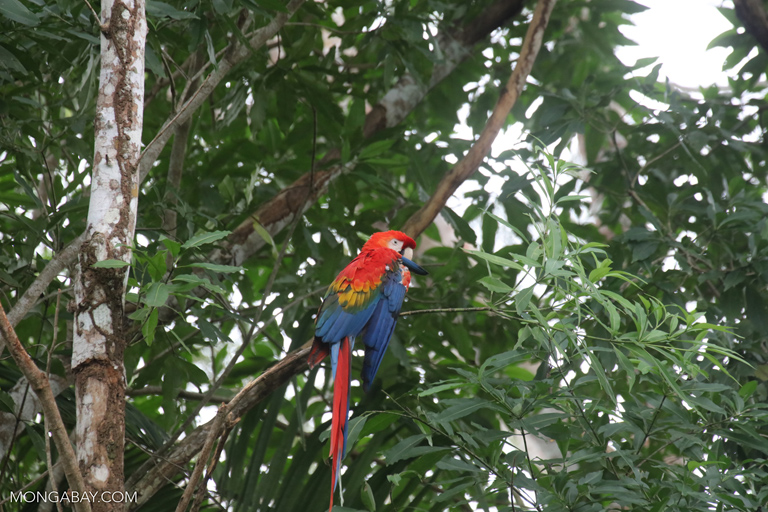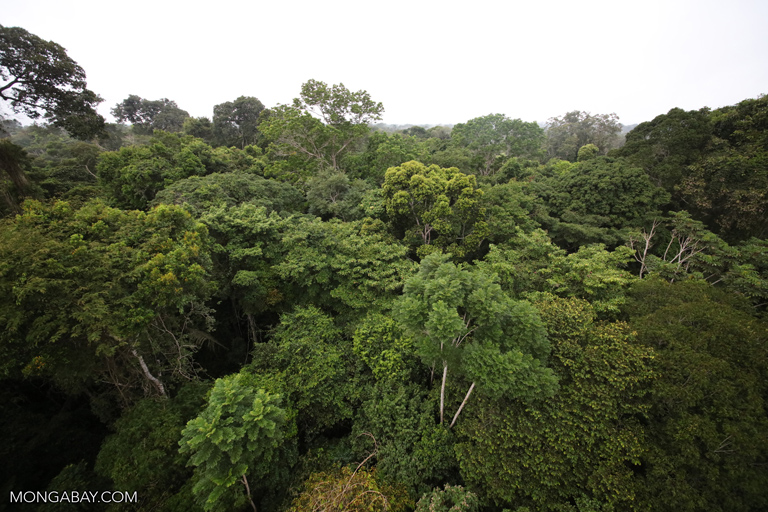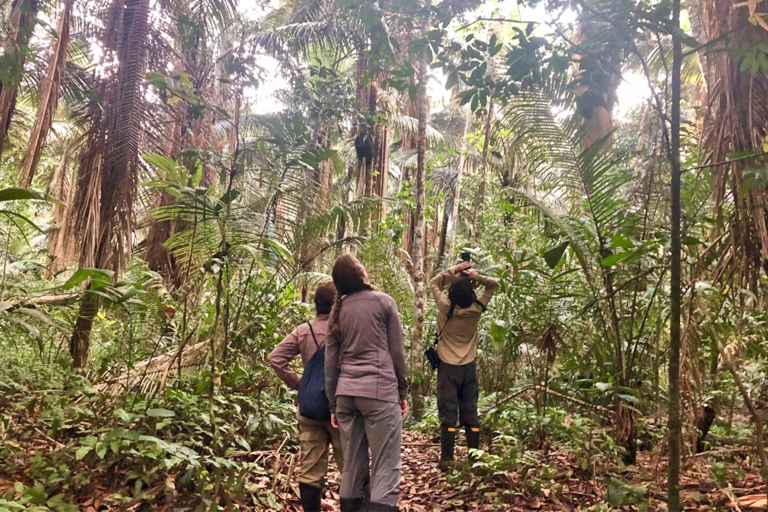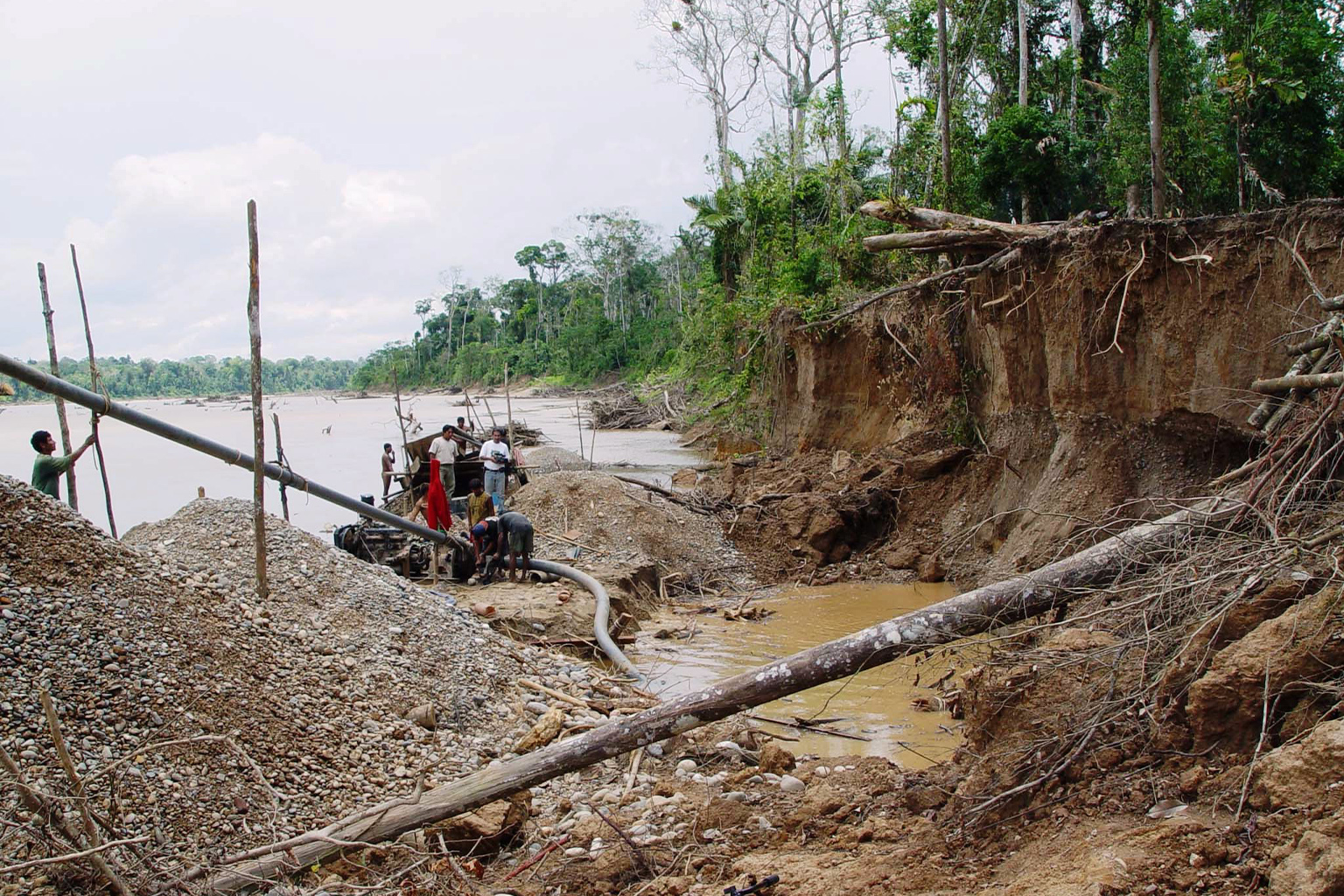- A recent study has found that forests in the southwestern Peruvian Amazon collect mercury from the atmosphere that’s used in artisanal small-scale gold mining in the Madre de Dios region.
- The study’s authors found “the highest ever recorded” levels of mercury from the “throughfall” that ends up on the forest floor when the leaves fall or rain washes the mercury from their surfaces.
- Mercury is highly toxic, causing neurological and reproductive problems in humans and other animals.
- Organizations are looking at different ways to reduce or even eliminate the use of mercury, which miners use to bind the flecks of gold found in the region’s riverine silt.
Years of artisanal mining along the Madre de Dios River and its tributaries have left their marks, both seen and unseen. Miners, swarming to the region in a modern-day goldrush, have cleared away pockets of this sliver of the Peruvian Amazon. The hangover from the continuing boom has left behind the telltale moonscapes of barren land, muddied streams and rivers, and an invisible toxin that fouls the water, the air and, as a recent study has shown, the forests themselves.
The study, published Jan. 28 in the journal Nature Communications, reveals that forests — and dense, intact forests in particular — sponge up mercury in the atmosphere that comes from gold mining in the Madre de Dios’s riverine soils. The mercury gathers on the surface of the leaves and in their tissues, and then rainfall washes it from high in the canopy to the forest floor, in a process that scientists call “throughfall.”
Levels of mercury found in that throughfall “were the highest ever recorded anywhere in the globe,” Jacqueline Gerson, the study’s lead author and a postdoctoral researcher at the University of California, Berkeley, said in an interview.
“That completely surprised us, that this area in the Amazon could have such high concentrations of mercury, higher than levels you’re seeing in industrial areas [or] in mercury mining areas,” she said. “And this all was happening within a biodiversity hotspot.”

Artisanal gold miners, who employ largely non-mechanized methods, add mercury to the slurry of gold-containing silt that washes down from the foothills of the Andes. When burned, the pellets of the resulting amalgam leave behind valuable pieces of gold. But some of that mercury inevitably leaches into the Amazon’s aquatic environments. There, in a process that still perplexes scientists, microbes tack on a methyl group and form methyl mercury, an exceptionally virulent toxin that targets the central nervous and renal systems of humans and other animals.
Earlier research has traced the pathway of methyl mercury through the food web and into the fish and other animals on which human communities in this part of the world often depend. But until now, it wasn’t clear what was happening to the mercury vaporized by burning. The study that Gerson led “was one of the first to really document where mercury is going in the environment, and the role of forests in actually sequestering that mercury,” said Marion Adeney, a conservation ecologist and director of Amazon and fire programs with the U.S.-based company Conservation X Labs, who was not involved with the study.

Making the connection
Mrinalini Watsa, one of the co-authors of the study, first came to this part of southwestern Peru in 2007. In the time since, she has seen seismic changes to the region. Mining has been happening in Madre de Dios for decades. Los Amigos Conservation Concession, a hub for researchers like Watsa and Gerson, was itself once a mining camp. Yet mining activity really started to rachet up after the 2008 financial crisis led many investors to put their money in gold. A 2013 study relying on airborne, satellite and on-the-ground surveys found a 400% increase in gold mining in Madre de Dios between 1999 and 2012.
In response to the surging demand, more miners, who are mostly from outside the region, made their way to Madre de Dios in a bid for hard-to-come-by economic security. About one-fifth of the world’s gold supply comes from such artisanal small-scale miners.
The “mining” that takes place is a laborious process, and wholly different from the pick-and-shovel process that might come to mind.
“You don’t strike gold in the Amazon,” said Watsa, a researcher with the San Diego Zoo Wildlife Alliance and the co-founder of the conservation education organization Field Projects International. “You are walking around on it. It’s on everything.”
Snowmelt-swollen streams flush gold-flecked silt from the foothills of the Andes, which tower “impossibly high on the horizon” above the Los Amigos concession, where the study’s researchers were based, Watsa said. In the lowland rivers, it collects at the highest concentrations in dead-end oxbow lakes. Miners will often clear the forest around these areas to set up their equipment and camps. Mining led to the loss of nearly 4,500 hectares (about 11,000 acres) of forest in Madre de Dios each year between 1999 and 2016, according to a 2017 study published in the journal Environmental Research Letters.
Once they’ve established a site, miners add mercury to barrels of river sediment they pull from the water, often “massaging” the highly toxic mercury into the silt with their bare feet, Watsa said.


The boom has also attracted a bevy of attendant services. Restaurants, mercury dealers and gold traders have set up shop in Madre de Dios, along with less savory enterprises. Despite recent efforts by the Peruvian government to regulate the industry, Watsa said, crime is rampant and law enforcement scant. Prostitution and drug use are common in the area.
Watsa did research for her doctorate at Los Amigos, and she typically spends several months a year at the conservation concession. On one of those visits, she noticed Gerson, who was a Ph.D. student at the time in ecology at Duke University.
Gerson and her team “would just go on these really slow boats up and down the river visiting site to site and collecting these methodical samples,” Watsa said. “I was just like, this is a really brave young woman.”
Watsa and her husband, disease ecologist Gideon Erkenswick, were working on their own project, aimed at tracking diseases in the region’s wildlife. But the surge in gold mining meant that mercury was “the big elephant in the room at this particular site.” They realized that the pathogens they found in the blood and fecal samples they collected might be causing disease. Or, she said, “It could just be the result of mercury toxicity because it’s so pervasive in that region.”

At the same time, Gerson was pursuing the various pathways by which mercury ends up in the environment. Prior research found that mercury can end up hundreds of kilometers downstream from mining along the rivers, potentially tainting the fish that are a vital source of protein to many communities. But Gerson and her colleagues wondered if wind patterns, for example, might be playing a role in the ultra-high blood mercury concentrations found in Indigenous groups who aren’t connected to mining sites by waterways or involved in mining themselves. So Gerson decided to turn her attention skyward, to the canopy above.
“Other studies throughout the world have shown that mercury can also enter into forests,” she said. “Given the large amounts of mercury that were being released from gold mining, we thought, well, forests are the question that no one’s looked at. Could mercury potentially be entering into these forest systems as well?”
To answer that question, Gerson and her colleagues collected leaves, both from the canopy and the leaf litter on the forest floor at five different sites along the serpentine Madre de Dios River, including a mix of deforested and intact forests, some of which sat closer to mining and others situated farther away. Along with the leaf samples, the team also collected air and soil samples at each of the sites.
Up to that point, however, the research didn’t have a way to trace the mercury through the ecosystem in living animals. So Gerson teamed up with Watsa and Erkenswick, adding their data on mercury levels in bird feathers to the assessment.

The hotspot
Los Amigos has recovered since the 1980s when, at times, dozens of miners could be working the site for gold. More recently, researchers have documented thousands of species, from pumas and giant otters to marmosets and spider monkeys, that live within the boundaries of the 1,460-square-kilometer (564-square-mile) concession. Today, though, active mining sites persist in the surrounding areas.
The broader Madre de Dios region, anchored by its namesake river, could be considered the biodiversity hotspot of all biodiversity hotspots. The region’s Manu National Park comprises verdant stands of untouched forest and a record-breaking menagerie of wildlife, leading UNESCO to call it perhaps the most biodiverse spot on the planet. Unlike to Los Amigos, parts of the park sit far from active mining sites.
The team used the contrasting sites to compare the impacts of mining on the uptake of mercury in animals. Specifically, they analyzed the tail feathers of several bird species caught and then released at Los Amigos and at Cocha Cashu, a biological station in Manu National Park that’s been relatively untouched by mining.
The birds from Los Amigos carried higher mercury loads than the birds from Cocha Cashu. What’s more, the Los Amigos levels were high enough to potentially affect the birds’ reproduction. The results show that mercury is finding its way into terrestrial as well as aquatic food webs.

As the team expected, the level of mercury in the air was higher near mining sites and lower at a greater distance from mining. Mercury concentrations in forests depended on more than just the proximity to mining sites: The levels also depended on the structure of the forest. Denser, more intact forests tended to have higher mercury concentrations in their leaves and soil than those from deforested or degraded areas, where the primary influx of mercury came from rainfall.
The plentiful leaves in the canopy of old-growth forests provide a broad surface area on which to collect mercury from the atmosphere, making it an ideal mercury sieve for the air. That led to those high “throughfall” readings the team found, rivaling even the places where mercury is mined from the earth. The analyses also showed that plants in these areas absorb the mercury into their tissues, so when leaves fall and decompose, they’re also adding to the overall mercury load.
“It’s actually a consequence of how special these forests are that they’re set up to capture this atmospheric pollution,” Emily Bernhardt, a professor of biology at Duke University and co-author of the study, told Mongabay.
And it’s yet another reason to make sure the forests aren’t cut or burned down, which could release that leaf-bound mercury and send it farther afield.
But even if the forests remain standing, Bernhardt said the mercury they’ve snapped up “does have consequences in the forest food web.” Once it finds its way to the soil, microbes transform it into that uber-toxic methyl mercury, gravely imperiling the health of humans and animals.


“This is an important study because it quantifies and spatializes mercury pollution from artisanal gold mining, and it shows how this pollution then threatens the local biota,” Camila Abe, an environmental engineer, formerly at Brazil’s National Institute for Space Research (INPE) and now a doctoral student in geography at San Diego State University, said in an email. Abe, who studies the impacts that gold mining has on the Amazon, was not involved in this research.
“Artisanal gold mining in the Amazon region is a very complex issue, involving environmental, social and economic issues,” Abe told Mongabay. “With that said, this problem also requires a complex solution that should address each of these levels.”
Still, most of the solutions targeting this issue boil down to one goal: controlling mercury.
“Reducing mercury emissions from gold mining is really the only way that we can prevent this mercury from bioaccumulating in the food web,” Bernhardt said.

Throttling the flow of mercury
For many people, artisanal gold mining is one of the few options to provide for their families, making it a challenge to tackle.
“You have this incredible tension between poverty and people’s need to make a living, and the need to conserve the forest,” Conservation X Labs’ Adeney said.
Alternative livelihoods to mining may exist, but they are rarely as accessible as mining. Brazil nut farming is sometimes mentioned, but Mrinalini Watsa points out that it can take 30 years for the trees to mature. By contrast, she has heard that some people can make $300 a day mining.
Watsa has also seen some miners become ecotourism guides, as Madre de Dios is consistently one of the most popular spots for visitors yearning for a glimpse of the Amazon rainforest. But, she said, when the COVID-19 pandemic hit in 2020 and tourists stop coming, some guides readily switched back to mining because “This [job] is what people do.”
The Peruvian government has taken steps to formalize gold mining in Madre de Dios, and Gerson and her colleagues note that these efforts may help keep mining out of protected areas like Manu National Park. Elsewhere in the Peruvian Amazon, the government’s Operation Mercury, a military-led crackdown on illegal gold mining, has lowered deforestation rates.
Regulating the industry could benefit the miners themselves, said Alex Dehgan, a conservation technologist and CEO and co-founder of Conservation X Labs.
“Formalization is critically important, because right now, the only choice for many of the miners is to work through the same criminal networks that are involved in trafficking and weapons and drugs and wildlife,” added Dehgan, who was not involved in this study.
But it doesn’t fully address the core issues of deforestation and mercury pollution that dog even regulated artisanal gold mining, Watsa said.
“It’s just as disruptive, only someone’s paying taxes,” she said.
Given that mining provides valuable economic benefits, and steady global demand makes that unlikely to change anytime soon, can mercury use — and therefore the noxious emissions — be reduced, as Bernhardt suggests?
Potential solutions include mercury sensors to monitor atmospheric levels of mercury. Another possibility is a device that captures the mercury vapors before they enter the atmosphere. Organizations are also working on scrapping mercury altogether and looking at different ways to mine gold without the use of mercury.

The Minamata Convention on Mercury was one of the first global efforts to tackle the mercury issue. To date, 136 countries, including Peru, have ratified the legally binding treaty since 2013, which is named after a city in Japan where a chemical plant’s wastewater caused widespread mercury poisoning in the mid-20th century. Peru has begun to develop its own plan to address mercury use and is one of the first countries to be part of the planetGOLD program aimed specifically at reshaping artisanal and small-scale gold mining.
Ludovic Bernaudat, from the chemicals and health branch of the United Nations Environment Programme (UNEP), said studies like this one are critical in achieving the goals of the convention.
“It is important for us to understand where the mercury that is used in artisanal and small-scale gold mining ends up in the environment,” Bernaudat said in an interview.
Through its Global Mercury Partnership, UNEP is working with governments, NGOs, businesses and scientists to reduce or completely eliminate the use of mercury by miners where possible, he said. Techniques include “gravimetric methods” to use gold’s relatively heavy weight to separate it from the sediment. Panning is a simple type of gravimetry.
Once the gold is concentrated, it requires less mercury to extract. Or miners could substitute other less toxic chemicals that bind more efficiently to gold.
“Mercury is not efficient to extract gold,” Bernaudat said. “It’s used because it’s cheap, and it’s available.”
Groups like Conservation X Labs have held contests to tackle the problem from different angles, but so far, “There’s no single silver bullet,” Dehgan said.
He added it’s critical to make sure the technology actually works in the conditions that miners face.
“It doesn’t matter if they don’t work in the places that you need them to,” he said. “We actually want to test in situ. We want the miners to be able to use these devices.”

Dehgan acknowledged that providing technology to miners is a controversial issue.
“We’re not trying in any way to promote artisanal-scale gold mining,” he said, “but the fact is, for 30 years, people have been working on this challenge, and we haven’t solved it.”
Because of its availability, mercury will likely continue to be the tool of choice at gold mining sites around the globe, with knock-on effects for the forests that surround them, along with the people and animals who depend on them.
Gerson said in a statement that the mercury issue goes beyond the fouling of water and that Indigenous communities in particular should be protected “from being poisoned through air and water.”
Nor is this an issue that affects only this corner of the Amazon.
“I don’t think that this phenomenon is unique to Peru,” she told Mongabay. “There are certainly many other locations where artisanal gold mining is happening in tropical forests that have similar complexity, and then we’d expect to find very high mercury concentrations as well.”
Banner image: Gold mining areas in Madre de Dios. Image courtesy of Conservation X Labs.
John Cannon is a staff features writer with Mongabay. Find him on Twitter: @johnccannon
Citations:
Asner, G. P., Llactayo, W., Tupayachi, R., & Luna, E. R. (2013). Elevated rates of gold mining in the Amazon revealed through high-resolution monitoring. Proceedings of the National Academy of Sciences, 110(46), 18454-18459. doi:10.1073/pnas.1318271110
Asner, G. P., & Tupayachi, R. (2016). Accelerated losses of protected forests from gold mining in the Peruvian Amazon. Environmental Research Letters, 12(9), 094004. doi:10.1088/1748-9326/aa7dab
Gerson, J. R., Szponar, N., Zambrano, A. A., Bergquist, B., Broadbent, E., Driscoll, C. T., … Bernhardt, E. S. (2022). Amazon forests capture high levels of atmospheric mercury pollution from artisanal gold mining. Nature Communications, 13(1). doi:10.1038/s41467-022-27997-3
Pitman, N. (2015). An overview of the Los Amigos watershed, Madre de Dios, southeastern Peru. doi:10.13140/RG.2.1.1620.4329
FEEDBACK: Use this form to send a message to the author of this post. If you want to post a public comment, you can do that at the bottom of the page.
